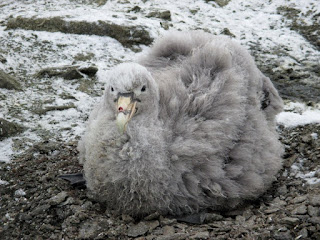A lot of my job involves counting and monitoring a variety of wildlife. The counting part of this has been particularly noticeable over the last couple of weeks.
First job was the whole island seal census. This involved all personnel on station, and took two full days. Every seal on the island, of every species, was counted. Some areas have a lot of seals and many of the fur seals look remarkably rock-like!


The beaches and low lying areas are particularly popular with the fur seals and elephant seals.

While the ice flows are much more popular with seals such as this leopard seal and weddell seals.

The seals have been counted almost every year, at the same time of year since 1977, allowing us to see the long term trends in their numbers. We got to just over 9000 seals in total this year.
Whilst out counting I came across this south polar skua.

Only a few of these nest on the island here. Most of the skuas here are the larger and darker, Brown skua. This picture shows both for comparison.

We have had a mild and rainy season here this year. When the sun finally decided to shine, everything on the lower slopes looked very green and un-Antarctic looking! This is a combination of green algae, mosses and lichen.

I have been feeling rather envious of all of the lovely snowy pictures people have been sending me from home while I have been out in the rain. The lack of snow turns everything dirty coloured- our beautiful snowy icecap has turned from this...

Into this...

The snow algae which develops on the surface can be green or red. The red algae can get very red!


With winter approaching, the temperatures this week have finally started dropping, allowing us to have some snow.

It was such a refreshing change from the rain and transformed Signy back into being an Antarctic winter wonderland. The west coast, still with plenty of icebergs was looking particularly wintery.

The second big count that needed to be done was the whole island giant petrel chick count. We had counted all of the nests earlier in the season, but need to know how many of these have survived. Giant petrel chicks are not blessed with good looks, but they have a lot of character and I am very fond of them.
They come in a grey morph...

Or a white morph...

Both are very well camouflaged on a snowy day and despite their large size, they were tricky to spot in the grey and white snowy landscape.
Back on station, on a rainy sunday afternoon, we made penguin cookies...

We have only three weeks left here now til the end of the season. My fieldwork is winding down and my focus switches to packing boxes and samples, counting things and tidying up from the season. None of this is too arduous and it makes a change from being in the field almost every day. There are still plenty of reasons to get outside, and it is nice to pick and chose the nicer days instead of having to be out in whatever weather Signy decides to throw at us!























































